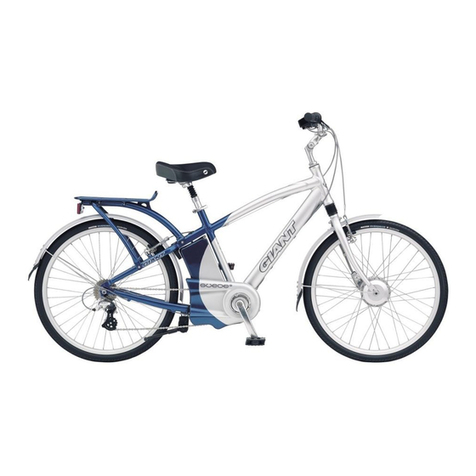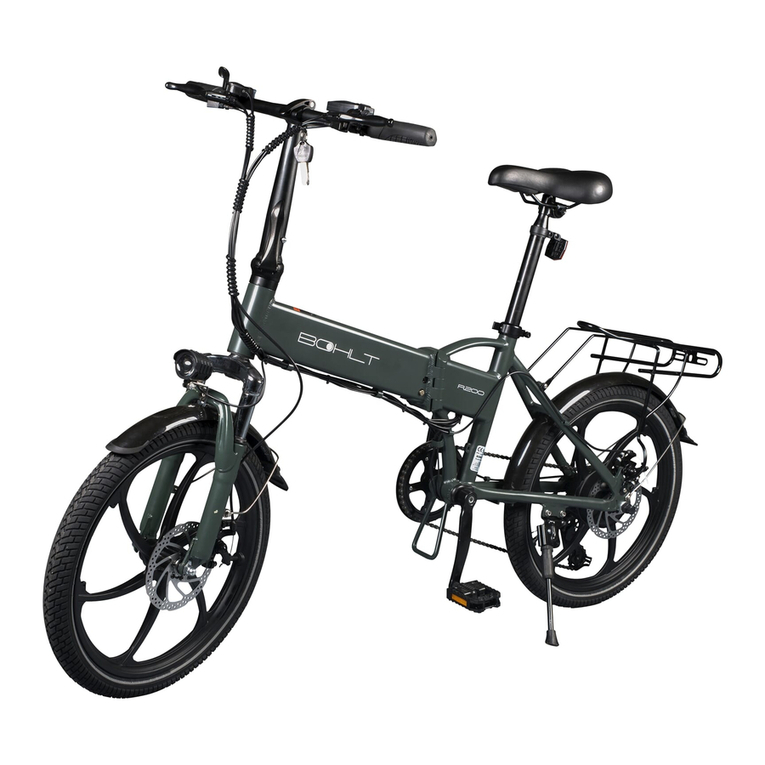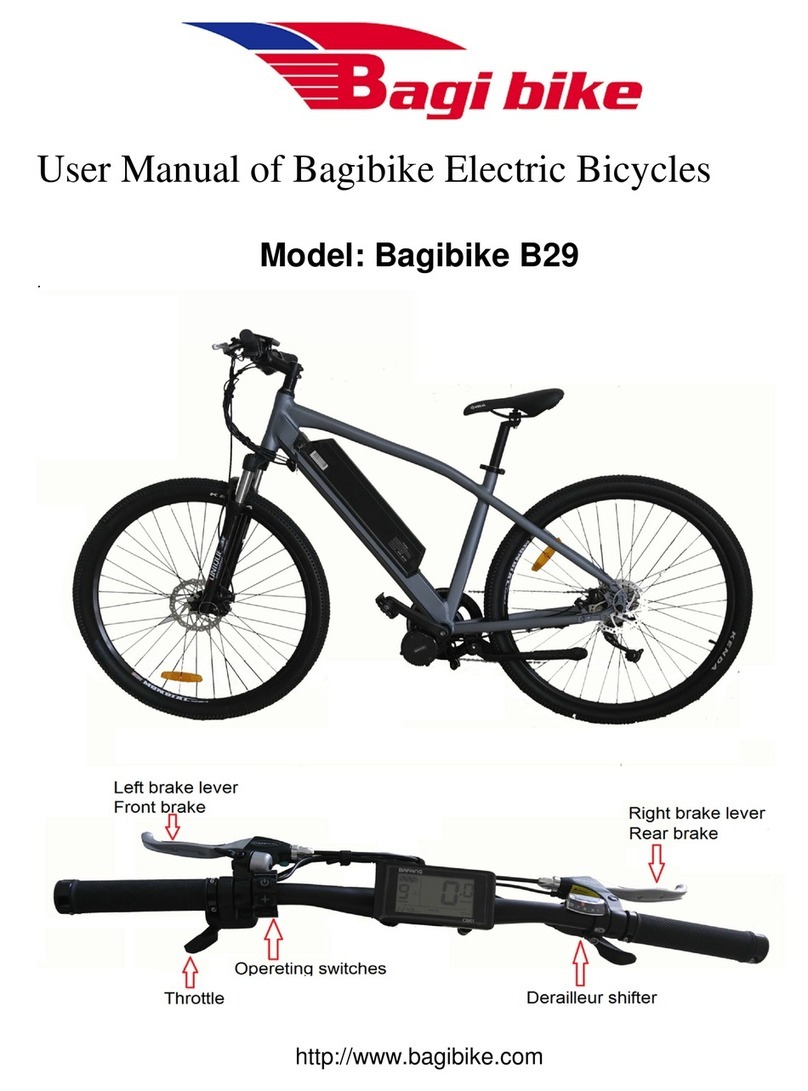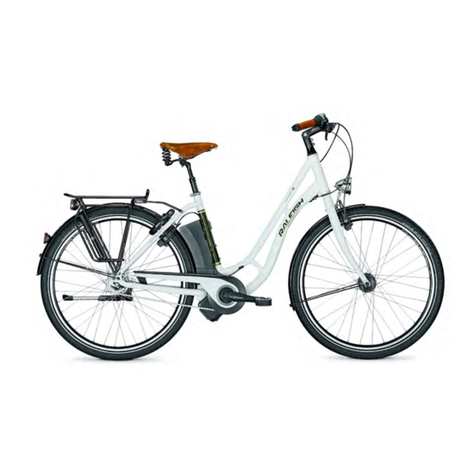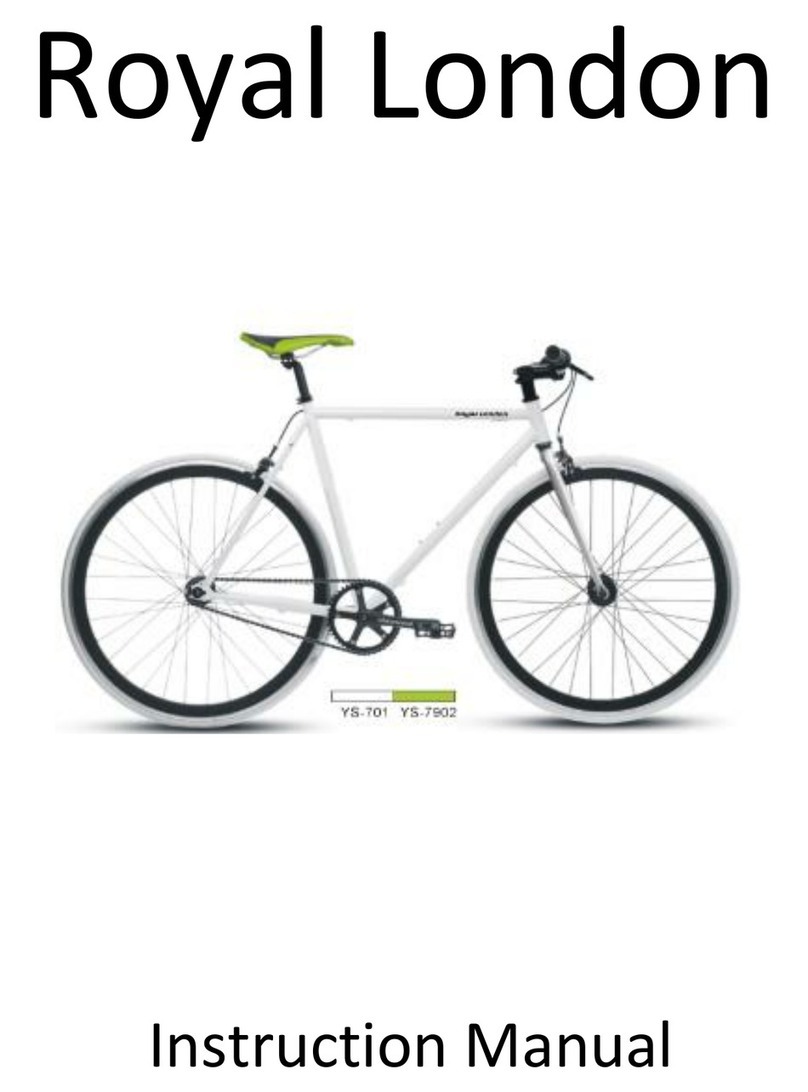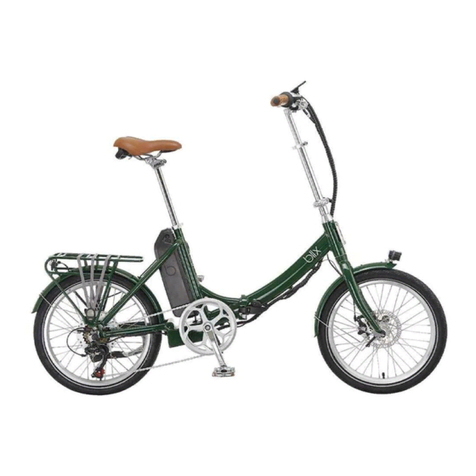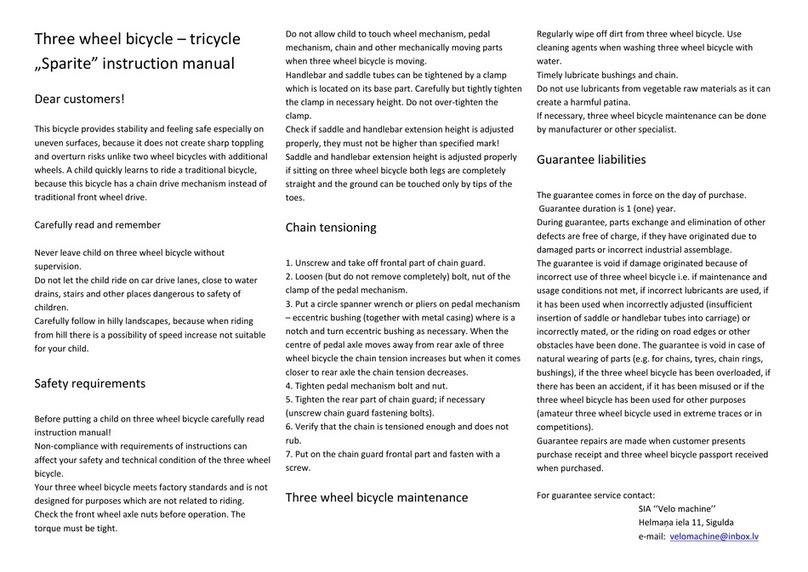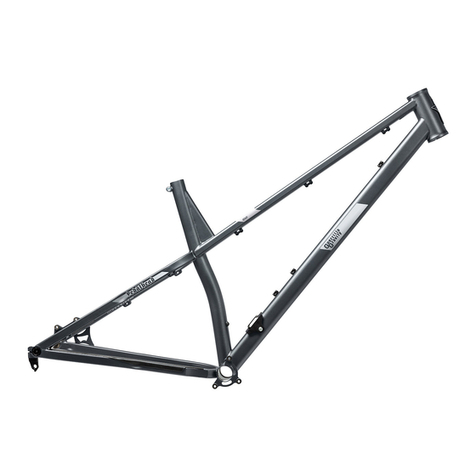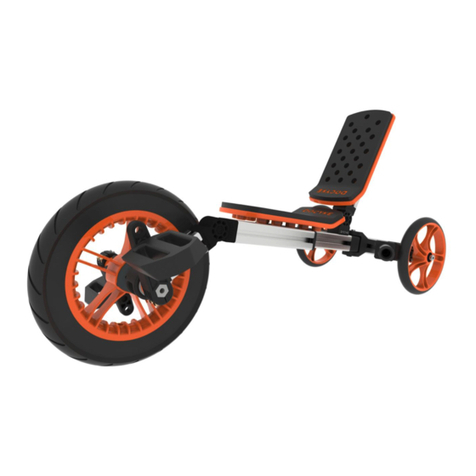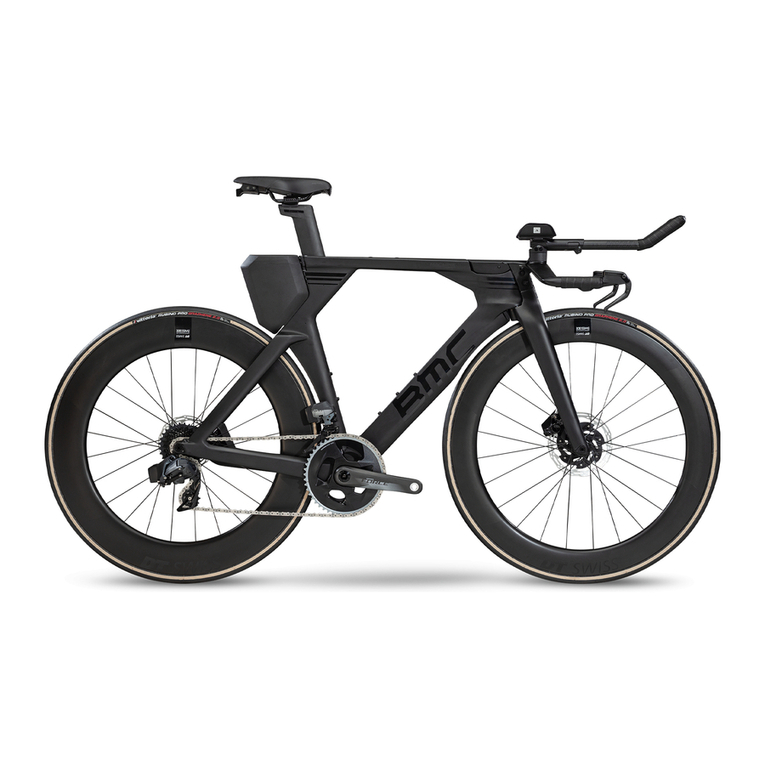Technibike E-MTB User guide

TECHNIBIKE E-MTB
ENGLISH
ORIGINAL INSTRUCTION MANUAL
Part# 731-00178
Mountainbike DIN EN ISO 4210:2014 · Pedelec/e-bike DIN EN ISO 15194:2017-12

U2
If you leave this page unfolded when you read this guide, you can immediately recognise which part of the bicycle is being addressed.
Frame
Top tube
Down tube
Seat tube
Head tube
Chain stays
Seat stays
Seat
Dropper/-seatpost
Seat post clamp, hardtail with quick release
Battery
Rear shock
Brake disc
Disc brake caliper
Dropout
Derailleur cassette
Rear derailleur
Chain
Electric drive
Crank arm
Pedal
Stem
Handlebars with grip
Display/Remote e-system
Remote control dropper seatpost
Brake lever
Shifter
Headset
Shifter cable
Brake cable
Battery lock
Suspension fork
Disc brake caliper
Brake disc
Wheel:
Hub dynamo
Spoke
Tire
Rim
Valve
Pedelec parts
8Fastening front wheel (bolted axle/thru axle/quick release)
7Fastening rear wheel (bolted axle/thru axle/quick release)
6
5
4
4
3
3
2
2
1
1
5
6
78

A
Dear Customer,
To start with, we’d like to provide you with some
important information about your new bicycle*.
This will help you make the most of its benets
and avoid any possible risks. Please read this
instruction manual carefully and keep it for your
future reference.
Your bicycle has been handed over to you fully
assembled and adjusted. If this is not the case,
please contact your specialist retailer to ensure
that this important work is completed or make
sure you carefully read the enclosed assembly
instructions and follow all the directions given.
It is assumed that users of this product have a
basic and sufcient knowledge of how to use
bicycles.
Everyone that:
• uses
• repairs or services
• cleans
• or disposes of
this bicycle has to understand and take note of
the content and purpose of this operating man-
ual. If you have any further questions or have
not quite understood certain points, you should
contact a specialist bicycle retailer for your own
safety.
All information contained in this operating man-
ual relates to the design, technology as well as
care and maintenance of your bicycle. Please
take note of this information, as much of it is
relevant to safety. Failure to consider this infor-
mation can cause accidents, falls and damage
to property.
As modern bicycle technology is highly com-
plex, we have chosen to only describe the most
important points.
In addition, this operating manual only applies
to the bicycle with which it was supplied.
For more specic technical details, please refer
to the enclosed notes and instructions from the
respective manufacturers of the individual com-
ponents used. If you are unsure about a particu-
lar point, please contact your specialist retailer.
Before riding your bicycle on public roads, you
should inform yourself about the applicable na-
tional regulations in your specic country.
Firstly, here are a few important pointers as to
the rider’s person which are also very important:
• Always wear a suitable bi-
cycle helmet adjusted to t
your head and wear it for
every ride!
• Read the instructions sup-
plied by your helmet manu-
facturer relating to tting the helmet properly.
• Always wear bright clothing or sportswear
with reective elements when you ride. If you
are riding in difcult terrain, please wear suit-
able protective clothing, e.g. body protectors.
• Always wear tight clothing on your lower
body, and trouser clips if required. Your shoes
should be grippy and have stiff soles.
Even if you are an experienced bicycle user,
please take the time to rst read the chapter “Be-
fore your rst ride” and then carry out all the impor-
tant checks from the chapter “Before each ride”!
Please note that as a bike rider, you are particu-
larly at risk on public roads.
Ensure that you protect yourself and others with
responsible and safe riding!
Note for parents and legal guardians:
As your child’s legal guardian, you are respon-
sible for your child’s actions and safety. This in-
cludes responsibility for the technical condition
of your child’s bicycle and adjusting it to t your
child’s body size.
Please inform yourself of what you and your
child absolutely must pay attention to by reading
the “Children” and “Legal regulations” sections.
In addition, you should also ensure that your
child has learnt how to use the bicycle safely.
The child should know how to use the bicycle
properly and responsibly in the environment in
which it will be used.
* In this original instruction manual the term “bi-
cycle” is used for both bicycles without an auxil-
iary electrical motor and for Pedelecs.

B
Safety information
Please carefully read all warnings and notes in
this operating manual before using the bicycle.
We recommend keeping the manual close to
your bicycle, so that it is always at hand. Be-
fore operating a pedelec for the rst time, it is
also highly recommended that you carefully read
through the enclosed instructions about the elec-
tric motor.
Please ensure you read the chapters “Before
the rst ride” and “Before each ride” before
using the bicycle for the rst time!
If you lend your bicycle to a third party, please
give them this operating manual with the bicycle.
This operating manual contains different types
of pointers – one providing important informa-
tion about your new bicycle and how to use it, a
second referring to possible damage to property
and the environment, and a third type warning
against potential falls and serious damage, in-
cluding physical injury. The fourth type of point-
er asks you to comply with the correct torque in
order to prevent components from coming loose
or breaking.
If you see this symbol, there is always a risk that
the danger described can occur!
The text which the warning covers always has a
grey background.
Check that all quick releases are safe and secure
every time you ride after your bicycle was un-
used, even for a short period of time! Regularly
check that all bolts and components are secure.
Note that components made of composite mate-
rials, i.e. carbon bre, often require a lower tight-
ening torque (see “Bolted connections” section,
page 25). Common parts made of carbon bre
include the handlebars, stems, seat posts and
saddle rails, frames, forks, and cranks. Ask your
specialist retailer to instruct you on how to prop-
erly use and maintain these materials.
Never ride with your hands off the handlebars.
Modern bicycle technology is high
tech! Working on bicycle parts there-
fore requires special knowledge, ex-
perience and specialist tools! Please do not
attempt to work on the bicycle yourself! Give
your bicycle to a specialist retailer for repair,
servicing and maintenance!
The warnings break down as follows:
Information: This symbol pro-
vides information about how to
use the product or highlights
specic parts of the operating
manual that are particularly important.
Warning: This symbol is aimed
at warning you against improper
use that could result in damage
to property or the environment.
Danger: This symbol indicates
possible dangers to your health
and life that could arise if specif-
ic actions are not taken or corre-
sponding regulations adhered to.
Important bolted connection!
Please adhere to the exact rec-
ommended torque when tight-
ening this connection. The cor-
rect mounting torque is either displayed on
the component or listed in the table of tor-
ques in the “Bolted connections” section
(page 25). A torque wrench has to be used
to achieve the precise prescribed torque. If
you don’t own a torque wrench then you
should always leave this work up to a spe-
cialist retailer! Parts which do not have the
correct torque could fall off or break! This
can result in serious accidents!
The illustration shows a full suspension mountain bike. The bike you purchased may look somewhat different. This manual describes bicycles in the
following categories: Mountain bike, All Mountain, Enduro, Freeride/Downhill, Dirt/Street/Freestyle bike, Cross bike/ATB, Fatbike, Single-speed
bike/Fixie, BMX, Pedelec/e-bike. This instruction manual only applies to the bicycle mentioned on the envelope with which it was issued.
MTB EN 7.0

1
Contents
Contents 1
Imprint 1
Before the rst ride 2
Before each ride 3
Legal regulations 4
Intended use 4
Adjusting the bicycle to the rider 7
Using quick releases and through axles 7
Through axles 8
Installing pedals 8
Setting up the seating position 9
Setting up the angle of the seat 9
Setting up the position of the handle-
bars/stem 10
Setting up the brake levers 10
Back pedal brakes 11
Children 12
Children’s bikes/ stabilisers 12
Transporting children/child bike trailers 12
Suspension 13
Maintenance / upkeep 15
Chain 15
Flat tyre repair for conventional tyres 18
Brakes 20
Vapour bubbles in the disc brakes 21
Gears 21
Inspection plan 22
Lubrication 24
Bolted connections 25
Loose accessories 26
Loose luggage rack 26
Attached accessories 26
Accessories/maintenance/
replacement parts 26
Rack 26
How to use carbon components 27
When you have purchased a BMX bicycle 28
What aspects are particularly important
to consider when riding a pedelec? 29
Legal regulations 29
Notes on electrical and electronic
components 30
Wear and warranty 31
Separate regulations for speed
pedelecs/e-bikes 32
Bike tuning is not permitted 35
Warranty and liability in the case of defects 35
Environmental protection tips 36
Inspections 36
Notes 40
Bicycle parts C2
Hand-over documentation C3
Bicycle identication C4
Introduction A
Safety information B
MTB EN Edition 7.0, May 2018
Imprint
For questions concerning your bicycle
please always contact your dealer rst, only
then in case the manufacturer of the bicycle.
For contact details please refer to the war-
ranty section, back cover or other included
information of the brand/manufacturer.
Responsible for sales and marketing
inMotion mar.com, Rosensteinstr. 22,
D-70191 Stuttgart, Germany
Tel +49 711 35164091
Fax +49 711 35164099#
info@inmotionmar.com
www.inmotionmar.com
Content and images
Veidt-Anleitungen
Friedrich-Ebert-Straße 32
D-65239 Hochheim, Germany
Legal inspection by a lawyer’s ofce special-
ising in intellectual property
This operating manual covers the require-
ments and scope of DIN EN ISO 4210:2014,
EN 16054 and DIN EN ISO 15194:2017-12.
In the case of delivery or use of this product
outside of the scope of the aforementioned
areas, the manufacturer of the bicycle is
required to supply the necessary operating
instructions.
© Multiplication, reprinting and translation
as well as any commercial use (including
extracts, in printed or digital form) is only
permitted if specically granted in writing in
advance.

2
Before the rst ride
Please also consult the additional operating
manuals of the individual component manufac-
turers, which were supplied with your bicycle or
available online.
Suspension
fork
Gear system
Electrical motor
Your specialist bicycle retailer will be happy to
answer any further questions you have after
reading this manual.
Please ensure that your bicycle is ready for use
and is adjusted to t your body.
That means:
• Setting the position and xture of the seat and
handlebars
• Checking the assembly and settings of the
brakes
• Securing the wheels into the frame and fork
To ensure that you enjoy a safe and comfortable
riding position, please allow your specialist retail-
er to set up your handlebars and stem.
Adjust the seat to a safe and comfortable position
for you (see page 9). Allow your specialist re-
tailer to set up the brakes so that the brake levers
are always within easy reach. Ensure that you
know which lever operates which brake (right/
left)!
The right brake lever operates the rear wheel
brake. The left brake lever operates the front
wheel brake. Despite this, however, you should
still check if the same rule applies to your bike’s
levers before riding it for the rst time, as this can
sometimes vary.
Modern braking systems might be
more powerful or have a different
functionality than those that you are
used to. Please familiarise yourself with the
brakes on a safe piece of land before setting
off on your rst ride with the bicycle!
If you use a bicycle with carbon bre rims,
please note that this material provides a sig-
nicantly worse braking effect in combina-
tion with rim brakes than aluminium rims do!
Also remember that the effectiveness of
brakes can be different, often worse, than
you are used to in wet conditions or on slip-
pery surfaces. Please take the possibility of
longer braking distances and slippery sur-
faces into account when riding!
If you are riding a single speed or a “xie”,
please familiarise yourself with its behaviour
under braking before your rst ride! Sin-
gle speed wheels with just one brake are
not permitted on public roads. Fixed-gear
bikes do not have a freewheel mechanism.
The cranks always turn whenever the back
wheel is turning.
If your bicycle has rubber or plastic
cage pedals, please familiarise
yourself with the grip which these
offer. In wet conditions, rubber and plastic
pedals can be very slippery!
Snagging hazard
Moving and turning parts of your
bike may lead to danger during use,
maintenance and upkeep.
Protect yourself by not wearing loose clothes
that may get caught. During use, mainte-
nance and upkeep, stay away from turning
parts (wheels, brake discs, cassettes). Do
not touch moving, sharp or protruding parts
(chains, pedals).
Ensure that the wheels are securely fastened in
the frame and fork. Check that all quick release
skewers, through axles and all important nuts
and bolts are secure (see page 7 and 25).
Lift your bicycle up slightly and drop it onto the
ground from about 10 cm in the air. If it rattles
or makes another unusual noise, ask a specialist
retailer to identify and x the problem before you
ride.
Push the wheels forwards with the brakes ap-
plied. The back brake should completely pre-
vent the back wheel from moving, while the front
brake should lift the back wheel off the ground
with its braking effect. Please take an initial test
ride in a safe place where you can familiarise

3
yourself with the new brakes! Modern brakes can
behave completely differently under braking than
those that you are perhaps used to. The bicycle’s
steering should not rattle under braking or exhibit
any play.
Check the air pressure in the tyres. You will nd
instructions as to the correct tyre pressures on the
sides of the tyres. Please adhere to the required
minimum and maximum pressure! If you cannot
nd any recommended pressures, 2.5 bar / 36 PSI
is a suitable pressure for most tyres. If the wheels
are thinner than 30 mm or 11/8“, the tyre pres-
sure should be lled to 4 bar / 58 PSI.
As a general rule of thumb when you are out on
a ride, you can check the tyre pressure by do-
ing the following: If you place your thumb on a
pumped up tyre, you should not be able to sig-
nicantly change its shape by applying pressure.
Check the tyres and rims. Scan them for any
damage, cracks or deformations, as well as em-
bedded particles, e.g. shards of glass or sharp
stones.
If you should nd any cuts, rips or holes, please
refrain from riding! First have your bicycle
checked over by a specialist.
Before each ride
Before every ride, please check that:
• The lights and bell are working and safely se-
cured
• The brakes are working safely and are prop-
erly secured
• The cables and ttings are not leaking if you
have a model with hydraulic brakes
• The tyres are free of foreign objects and dam-
age, and the rims are not damaged and run
true, particularly after riding off road
• The tyres have a sufcient tread depth
• The suspension components are working
properly and are safely secured
• All bolts, nuts, through axles and quick releas-
es are tight (see pages 7 and 25)
• There are no deformations or cracks on the
frame and fork.
• The handlebars, stem, seat post and seat are
both correctly and securely fastened as well as
set up in the right position
• The seat post and seat are secure. Try turning
the seat or tipping it upwards or downwards. It
should not move.
• If you are using clipless/magnet pedals, please
check that they are working properly. The ped-
als should release easily and smoothly.
• For BMX bicycles: the rotor works safely, the
handlebars are safely secured in the stem and
the axle pegs are safely secured.
If you are unsure of whether your bi-
cycle is in a sound technical condi-
tion, take it to a specialist retailer to
be checked instead of riding it!
It is particularly important if you use your
bicycle a lot, either through sports riding or
daily use, that you regularly have all the im-
portant parts checked by a specialist retailer.
Frame and fork, suspension components
and other parts relevant to your safety such
as brakes and wheels are subject to heavy
wear, which can impact the operating safety
of these parts.
If you use parts for longer than their intended
lifetime, these can fail without warning, which
can in turn lead to falls and serious injury!
Please make these checks before
continuing after a fall or if your bicy-
cle falls over!
Aluminium parts cannot be safely bent back
into shape, while carbon components can
sustain damage which is not recognisable
to the eye.
Allow the bike to be checked by a specialist
retailer.

4
Legal regulations
Before riding your bicycle on public roads, you
should inform yourself about the applicable na-
tional regulations in your specic country.
This section provides information on how the bi-
cycle has to be equipped to be permitted to par-
ticipate in public road trafc.
Here you can nd out which light systems have to
be installed or carried with you and which brakes
the bicycle has to be equipped with.
There is also an explanation of which age re-
strictions apply and what age rid-
ers have to be to ride where. The
participation of children in public
road trafc is also addressed here.
If there is an obligation to wear a
helmet, it is stated here. Info
Intended use
Bicycles are intended for transport-
ing one person at a time. If you are
planning to transport additional
people, you should inform yourself about the
applicable national regulations in your spe-
cic country. If you would like to transport
baggage, this requires that your bicycle is
tted with suitable equipment. Children can
only be transported in children’s seats or
trailers intended for this purpose. We rec-
ommend not taking any chances when it
comes to quality in this area!
Ensure that you do not exceed the maxi-
mum permissible weight.
(see page C5)
Maximum permissible weight: Rid-
er’s weight + Bicycle weight + Bag-
gage weight
The information provided in this operating man-
ual only applies to the types of bicycles listed on
the cover. Information on individual models is la-
belled accordingly. Using the bicycle as intended
also means adhering to the operating, mainte-
nance and upkeep conditions described in this
manual.
Dangers of improper use
Only use your bike for its intended
use. Read the section “Intended Use”.
This also includes adherence to the operat-
ing, servicing and maintenance conditions
that are described in this manual.
Inform other users of the intended use and
the dangers of not adhering to it.
Improper use, overloading and lack of mainte-
nance may lead to accidents and falls involv-
ing severe injuries to you and other people!
If your bicycle is equipped in line with national
law, the following is permitted:
Type 1
MTB – spring travel up to approx. 120mm
and appropriately
equipped pedelecs,
youth bicycles and single
speed/xie bicycles can
be used on public roads
and light off-road conditions such as eld paths,
trails and cross-country courses. They may be
used to ride over small obstacles such as roots,
rocks or steps. Appropriate protective equipment
(suitable helmet, gloves) should be worn.
Manufacturers and dealers are not liable for
damage resulting from use outside of intended
use. This applies particularly to damage resulting

5
from non-adherence to the safety instructions,
e.g., in terms of:
• Using the bicycle on rough terrain, for jumps,
steep descents, in bike parks
• Carrying excess weight or
• Making improper repairs to defects
These bikes are not designed for extreme im-
pact. This includes riding over steps, bike jump-
ing, extreme use in authorised biking competi-
tions, doing tricks and performing stunts.
Type 2
All Mountain – spring travel approx. 120–150mm
and appropriately
equipped pedelecs can
be used on public roads
and off-road. They may
be used to ride over
obstacles such as roots, rocks or steps. Small
jumps are permitted. Appropriate protective
equipment (suitable helmet, gloves, protectors
as necessary) should be worn.
Manufacturers and dealers are not liable for
damage resulting from use outside of intended
use. This applies particularly to damage resulting
from non-adherence to the safety instructions,
e.g., in terms of:
• Using the bicycle in extreme off-road conditions,
for high jumps, steep descents or in bike parks
• Carrying excess weight or
• Making improper repairs to defects
Bicycles are generally not designed to withstand
extreme stress, such as steep descents or high
jumps, nor heavy-duty use, such as authorised
competitive events, tricks or stunts.
Type 3
Enduro – spring travel approx. 150–180mm
and appropriately equipped pedelecs can be
used on public roads and off-road. They may be
used to ride over obstacles such as roots, rocks
or steps. Jumps are permitted. Appropriate pro-
tective equipment (suitable helmet, full-nger
gloves, protectors as necessary) should be worn.
Manufacturers and dealers are not liable for
damage resulting from use outside of intended
use. This applies particularly to damage resulting
from non-adherence to the safety instructions,
e.g., in terms of:
• Using the bicycle on rough terrain, for high
jumps, steep descents or hard riding in bike
parks
• Carrying excess weight or
• Making improper repairs to defects
These bikes are not designed for extreme stress.
This includes steep descents or high jumps, ex-
treme use in authorised biking competitions, do-
ing tricks or performing stunts.
Type 4
Freeride / Downhill – spring travel from 180mm
and appropriately equipped pedelecs can be
used on public roads and off-road. They may be
used to ride over obstacles such as roots, rocks
or steps. Jumps are permitted. Appropriate pro-
tective equipment (full-face helmet, full-nger
gloves, protectors) should be worn.
Manufacturers and dealers are not liable for
damage resulting from use outside of intended
use. This applies particularly to damage resulting
from non-adherence to the safety instructions,
e.g., in terms of:
• Using the bicycle on rough terrain, for very
high jumps, steep descents or hard riding in
bike parks
• Carrying excess weight or
• Making improper repairs to defects
These bikes are not designed for extreme stress.
This includes extreme use in authorised biking com-
petitions, doing crazy tricks or performing stunts.

6
Type 5
BMX
and appropriately equipped youth bicycles and
single speed/xie bicycles can be used on public
roads and light off-road conditions such as eld
paths, BMX trails, ramps and skate parks. They
may be used to ride over small obstacles such
as roots, rocks or steps. Appropriate protective
equipment (suitable helmet, gloves, protectors)
should be worn.
Manufacturers and dealers are not liable for
damage resulting from use outside of intended
use. This applies particularly to damage resulting
from non-adherence to the safety instructions,
e.g., in terms of:
• Using the bicycle on rough terrain, for jumps,
steep descents, in bike parks
• Carrying excess weight or
• Making improper repairs to defects
These bikes are not designed for extreme stress.
This includes steep descents or high jumps, ex-
treme use in authorised biking competitions, do-
ing tricks or performing stunts.
Type 6
Dirt / Street / Freestyle Bikes
and appropriately equipped youth bicycles and
single speed/xie bicycles can be used on pub-
lic roads and off-road such as eld paths, BMX
trails, ramps and dirt lines. They may be used to
ride over obstacles such as roots, rocks or steps.
Appropriate protective equipment (suitable hel-
met, gloves) should be worn.
Manufacturers and dealers are not liable for
damage resulting from use outside of intended
use. This applies particularly to damage resulting
from non-adherence to the safety instructions,
e.g., in terms of:
• Using the bicycle on rough terrain, for very
high jumps, steep descents or hard riding in
bike parks
• Carrying excess weight or
• making improper repairs to defects
These bikes are not designed for extreme stress.
This includes extreme use in authorised biking
competitions, doing tricks or performing stunts.
Participating in a competition is only permissible if
the manufacturer has designed the bike to do so.
Type 7
Crossbikes / ATBs
and appropriately
equipped pedelecs
youth bicycles and sin-
gle speed/xie bicycles
can be used on public
roads, and light off-road conditions such as eld
paths. They may be used to ride over small ob-
stacles such as roots or rocks.
Manufacturers and dealers are not liable for
damage resulting from use outside of intended
use. This applies particularly to damage resulting
from non-adherence to the safety instructions,
e.g., in terms of:
• Using the bicycle on terrain,
• Carrying excess weight or
• Making improper repairs to defects
These bikes are not designed for extreme im-
pact. This includes riding over steps, bike jump-
ing, extreme use in authorised biking competi-
tions, doing tricks and performing stunts.
Participating in a competition is only permissible if
the manufacturer has designed the bike to do so.
If you are not certain about which kind of bike
you have, ask your specialist retailer or the man-
ufacturer about its use and limitations. Inform
yourself about current legislation before riding
your bike on public roads and pathways. Only
ride on routes which are permitted for your type
of bicycle.
Special regulations may apply in part. Please in-
form yourself about the applicable national regu-
lations in your specic country.

7
Adjusting the bicycle to the rider
The seat post, seat, stem and handlebars can be
fastened with quick releases or bolted connec-
tions.
Please ensure that you read the
manufacturer’s operating manual
for your stem. Only allow specialists
to work on your handlebars and stem!
Possible positions for adjusting bolted connections
Possible positions of quick releases/ through axles
Using quick releases and through axles
Quick releases and through axles are systems
installed on the bicycle in place of bolted con-
nections. They consist of two parts: the clamping
lever, which provides the necessary clamping
force, and the locking nut, which allows you to
regulate the clamping force. You can change the
setup of your quick release when the clamping
lever is open.
A good gauge for measuring if the
wheel is safely clamped is if you can
only close the clamping lever with the
balls of your hands when the resistance in-
creases after closing the lever about half way.
Loosening adjusting nuts
Tightening adjusting nuts
• Check that all quick releases are
properly fastened before every ride.
• Make sure that all quick releases
and through axles are properly in place
even if the bike was only left unattended
for a short period of time.
• When it is closed, the quick release lever
should be at against the frame, fork or
seat post!
• When it is closed, the end of the quick
release lever should always point back-
wards. This ensures that it cannot be
opened through contact during riding.
* see page 25

8
Through axles
If your bicycle has one or several
through axles, please read the cor-
responding instructions provided by
the component manufacturer on how to op-
erate and service these parts.
Through axles that mostly function – and must be
handled – like quick releases, are also currently
used in chassis in lieu of bolts.
The axle is screwed into the drop-out and se-
cures the hub between the two fork arms or the
drop-outs in the frame. With some systems, the
hub and axle are secured with a quick release le-
ver operated in the same way as a normal quick
release skewer. Systems in which the axle is only
inserted or screwed in and then fastened with a
screw also exist. Refer to the attached compo-
nent manufacturer instructions and allow your
dealer to explain the system to you in detail.
Quick-release axle in the fork dropouts, without hub, Rock Shox
®
fork
Inappropriately installed wheels
may shift while you are driving or
detach from the vehicle. This may
damage the vehicle and expose the driver to
severe and life-threatening injuries. It is
therefore important to take note of the fol-
lowing instructions:
• Ensure that your axle, drop-outs and
through axle mechanisms are free from
dirt and contamination.
• Ask your dealer for exact instructions on
the proper way to secure your wheel in the
through axle system on your bicycle.
• Fasten your wheel appropriately with the
through axle.
• Never use the bicycle unless you are sure
that the wheel has been properly secured
and cannot come loose.
Mounting
Place the wheel in the dropouts. The wheel hub
must be fastened securely in the dropouts. Close
the xing mechanism.
Ensure that the brake disk is properly inserted
into the brake calliper. Ensure that neither the
brake disk nor the hub or the brake disk fasten-
ing screws touch the lower parts of the fork. If
you do not know how to adjust the disk brakes of
your bike, please read the instructions provided
by your disk manufacturer.
Installing pedals
If your bicycle was supplied without the pedals
pre-installed, these have to be attached with
the correct wrench. Please note that the ped-
als have to be screwed in in different directions
and secured with a high mounting torque (see
page 25). Apply assembly grease to both
threads.
Ensure that you read the manufac-
turer’s instructions before using
magnet or clipless pedals. Practice
clipping your shoes in and out of the pedals’
locking system before your rst ride in a qui-
et, safe place. Clipless pedals which do not
properly release are a safety hazard.
In the case of magnet pedals, you
are able to adjust how much force is
required to release the shoe from
the pedal. Please test this on your rst ride
with a setting that releases very easily! Reg-
ularly clean your magnet pedals and keep
them in good condition with a suitable spray
lubricant.
Forwards
* see page 25

9
Setting up the seating position
Before you use your bicycle for the rst time, the
seating position has to be set up to suit your body
size. This is vital for riding safely and securely.
To do this, the seat’s height, alignment and angle
have to be set up, as do the height and alignment
of the handlebars with the stem.
Knee joint of the upper leg at
min. 90°, angle of arm 90°
Correct seat height
90°
90°
90°
The knee should be above the
axle of the front pedal
90°
Setting up the angle of the seat
When you have set the height of the seat, you
have to check that the angle of the seat is suit-
able. In general, the upper surface of the seat
should be horizontal. You can adjust this by loos-
ening the clamping bolts in the seat post.
Patented seat post with two-screw locking mechanism
Patented seat post with one-screw locking mechanism
Attachment with seat clamp
Suspension seat post
Before you start riding, please test
to see if your seat post and seat are
secure. To do this, grab the seat at
the front and back and attempt to turn it. It
should not move.
If your mountain bike is equipped with a telescop-
ic seat post, please ensure you read the instruc-
tions provided by the manufacturer before use.
Telescopic seat post with
remote control
Please ensure that you read the part
manufacturer’s operating manual
when setting up and operating sus-
pension seat posts or telescopic seat posts.
When adjusting the height of the
seat, never pull the seat post further
out than the maximum extension
length marked! If your tube does not have a
maximum marking, then you must leave a
minimum insertion length of 7.5cm.
* see page 25

10
7.5cm
STOP
For bikes with rear suspension, the seat post
should never come in contact with the spring ele-
ment located on the back wheel.
Setting up the position of the
handlebars / stem
Various types of stem are used on bicycles:
Quill stem
STOP
Height adjustment possible
Changing the position of the stem
also changes the position of the
handlebars. You should always be
able to safely reach and use grips and con-
trols. Please ensure that all cables and lines
are long enough to allow you to turn the han-
dlebars in every possible way.
Threadless stem
Height change possible as follows:
• Exchange of tted spacers under or above the
stem
• Turning of the stem
• Exchange of the stem
Only to be carried out by a special-
ised dealer
Adjustable stem
Adjustment of stem tilt possible
Please ensure that you read the
manufacturer’s operating manual
for your stem. Only allow specialists
to work on your handlebars and stem, do not
attempt to do this yourself!
BMX bicycles are ridden in a stand-
ing position. Please ask your spe-
cialised dealer which riding position
is suitable for you.
Setting up the brake levers
Set up your brake levels in such a way that you
can safely apply them and brake comfortably.
Please familiarise yourself with which lever oper-
ates which brake!
Some brakes are now equipped with power mod-
ulators. This guards against “overbraking” and
any dangerous locking of the wheels.

11
When you squeeze the brake levers
hard or all the way to the end of
their leverage, the braking force can
increase sharply! Please familiarise yourself
with this new braking behaviour. Ensure that
you receive and read the manufacturer’s op-
erating manual.
The brake levers should be set up
so that your hands can safely and
comfortably apply them as a straight
extension of your arms.
90°
90°
In order to allow people with smaller hands to
safely apply the brakes, the levers can be set up
to be closer to the handlebars using an adjusting
screw (located in the lever).
In some models it is
possible to bring the
brake levers closer to
the handlebars, using
special devices.
Set up the cable tension
in such a way that the
brake levers do not touch
the handlebar grip, even
when they are applied to
their fullest extent!
Adjusting
screw
Mechanical brakes
are usually able to be
readjusted by turning
the adjustment screw
located on the handle.
Loosen the adjustment
screw from the handle until the braking function
becomes more secure. Secure the adjustment by
tightening the locknut on the handle.
Back pedal brakes
If your bicycle is equipped with back pedal brakes,
you brake by pushing the pedals backwards in-
stead of forwards. This means that your bicycle
will not freewheel and you are unable to rotate the
pedals backwards freely as you otherwise can!
The safest way to brake using back
pedal brakes is when the line of the
pedals is horizontal. If one pedal is
at the top and one at the bottom, the poor
force output produced is not conducive to
effective braking!
The effectiveness of back pedal
brakes can deteriorate substantially
on long inclines! This type of brak-
ing system can become very hot from con-
tinuous braking. You should also use the
front brake to slow down on long inclines.
Try to give back pedal brakes the chance to
cool down and do not touch them.
Adjusting
screw
Lock nut

12
Children
Children’s bikes / stabilisers
As a parent or legal guardian, you have a major
responsibility when your child rides a bicycle and
therefore wants to ride on public roads!
• Take the time to accompany the child on its rst
ride in a safe and quiet place (car park, eld).
• Explain to the child that it should only ride with
a helmet and easily visible, bright clothing.
• Set up the seat and handlebars so that the
child is able to put its feet on the ground in
unsafe situations – it is important to have a re-
laxed seating position if your child is to control
the bicycle properly.
• Explain and practice using the front and rear
brakes. It is especially important to practice
using the backpedal brake and learning how
to carefully apply the handbrakes connected to
the front wheel.
If you are using stabilisers, please
make sure that you carefully read
the manufacturer’s assembly in-
structions! The stabilisers have to be abso-
lutely secure, as your child is relying on their
support! If they are not sure whether you
have correctly assembled the stabilisers,
please ask a specialist retailer for advice!
Using stabilisers can help a child
get used to riding a bicycle. It avoids
falls and helps children to feel safer.
However, rst the child gets used to riding
with this “tricycle” style bike. It doesn’t learn
to keep its balance and make the necessary
countermovements. That is why you have to
be particularly careful when you rst remove
the stabilisers. This is very unfamiliar for the
child and it rst has to learn this new skill.
Transporting children / child bike trailers
• Please only use safe, certied children’s seats!
• The child has to wear a helmet, its feet have
to be away and protected from any possible
contact with moving parts, such as spokes.
• A child seat changes the way your bicycle
behaves when riding. Take note of the longer
braking distances and the more unstable
steering. Practice riding with a child seat in a
safe area before taking to public roads.
• Please comply with the manufacturer’s instruc-
tions supplied with the seat.
Only install children’s seats on bicy-
cles which are suitable for this kind
of equipment.
Carbon bre frames and components are
not permitted to carry children’s seats!
Never attach a children’s seat to the seat
post! Wrap and protect all suspension and
moving parts on the seat and seat post.
Please ensure that your child cannot trap
its ngers anywhere! This would result in a
substantial chance of injury!
Find out about the legal regulations
which relate to the age of the child
and the rider.
If additional equipment was deliv-
ered with your bicycle, which was
not pre-assembled, please ensure
that you read the manufacturer’s instructions.

13
Child bike trailers:
• Take no chances in terms of quality when buy-
ing child bike trailers.
• Only install child bike trailers on bicycles and
only using mounting parts approved or intend-
ed for this purpose by the manufacturer.
• It is easy to oversee a child bike trailer in traf-
c! Use a brightly coloured ag and approved
light system to ensure that it is easily seen. Ask
your specialist retailer about safety equipment.
When a child trailer is attached to
the bike, it becomes much longer
than usual. A child trailer changes
the way your bicycle behaves when riding.
Take note of the longer braking distances
and the more unstable steering.
Practice riding the bike while pulling a child
trailer in a secure area. Please comply with
the manufacturer’s instructions supplied
with the seat.
Full suspension bicycles are not
suitable for use with trailers and
child bike trailers!
The bearings and attachments are not de-
signed to withstand this sort of force. This
could result in strong wear and breaks with
serious consequences.
Suspension
If your bicycle is equipped with suspension parts,
these have to be adjusted to the weight of the
rider and the intended use. This work requires
specialist knowledge and experience, so please
only carry this work out in coordination with a
specialist retailer. Please read the supplied oper-
ating manual for your bicycle’s suspension parts
A typical suspension fork may look as follows:
Adjusting spring
stiffness
Adjusting
damping
Spring travel
Suspension forks have to be set up in accord-
ance with the instructions provided by the fork
manufacturer. In general, the fork should notice-
ably “give” when riding over uneven surfaces, but
not reach the end of the travel.
A suitable basic setup would see the suspension
pushed in around 10–15% of the spring travel
when the rider is sitting normally on the bicycle.
Suspension forks can only function
effectively if they are regularly
cleaned. Purpose-made cleaning
agent or warm water with washing up liquid
is suitable here. Specialist retailers also
stock suitable spray lubricant for greasing
your suspension regularly, both after every
clean and otherwise. The same applies for
suspension seat posts.

14
Most suspension seat posts can be
adjusted to the rider’s weight. How-
ever, in most cases this requires the
seat post to rst be extracted from the
frame. Please talk to your specialist retailer
before carrying this out.
Suspension frames and their suspension-
related parts
In this case, the frame’s rear fork is exible and
has suspension and damping from a shock ab-
sorber.
Some shock absorbers use a steel spring to ab-
sorb undulations, while others do this with an
air chamber. The damping, which regulates the
speed of compression and stretching, can be ad-
justed in high quality shock absorbers.
Here is a depiction of a typical spring element:
Adjusting spring
stiffness
Adjusting
damping
For detailed information, please read the instruc-
tions supplied by the manufacturer.
A suspension part may only be adjusted according
to the manufacturer’s operating manual. In general,
the suspension part should noticeably “give” when
riding over uneven surfaces, but not reach the end
of the travel. A suitable basic setup would see the
suspension pushed in around 10–15% (cross
country), 15– 20% (touring) or 25– 33 % (endu-
ro, freeride, downhill) of the spring travel when
the rider is sitting normally on the bicycle.
Avoid washing your bicycle with a
high-pressure cleaner as the clean-
ing uid can penetrate sealed areas
due to the high pressure and then eventually
destroy them.
The shock absorber’s sliding pistons and gas-
kets should be carefully cleaned with a soft
cloth as part of your regular bicycle clean-
ing routine. Spray lubricant on the running
surface of the shock absorbers and gaskets
helps keep the system working effectively.
Special spray lubricant is available specical-
ly for this purpose, e.g. from Brunox®.
You should regularly check the links of the
rear fork for play. Grip the frame securely
and attempt to move the rear wheel side-
ways. You can also test for play in the shock
absorber attachment by rapidly lifting and
dropping the rear wheel. If you a) notice play
anywhere or b) hear rattling, you should im-
mediately take your bicycle to be checked
by a specialist retailer.
Avoid riding the bike until it has been repaired.
The functionality and secure t of
the suspension parts are vital for
your safety! Clean and check your
full suspension bicycle on a regular basis!
Warm water with a little washing up liquid or
light cleaning agents are suitable for clean-
ing this part of the bicycle.
Tighten all screws to the recom-
mended torque. Otherwise the
screws could break and parts could
fall off (see page 25).
Full suspension bicycles are not
suitable for use with trailers and
child bike trailers!
The bearings and attachments are not de-
signed to withstand this sort of force. This
could result in strong wear and breaks with
serious consequences.
If you have a full suspension frame
with a short seat tube which is open
at the bottom, the seat post can only
be lowered to the point that it does not touch
the spring element when it uses its full travel.

15
Maintenance/ upkeep
Please have your bicycle checked
by a specialist retailer on a regular
basis. These experts can identify
damaged and worn parts and are able to ad-
vise you in selecting replacements. Refrain
from repairing key parts yourself (frame,
fork, handlebars, stem, headset, brakes,
lights).
As is the case for all mechanical
parts, bikes take on wear, tear and
heavy use. Because of heavy use,
different materials and components can react
to wear and tear in different ways. If a compo-
nent is used for longer than it is designed for,
it may suddenly stop working and possibly
lead to injury or cause additional damage.
Any kind of rip, puncture or colour change
seen in an overused area indicates that the
component’s use has reached its limit; the
component should in this case be replaced.
When replacing the original tyres or the
cranks, make sure that there is enough free
space between the tyres and the shoe. Acci-
dents and severe falls could otherwise occur.
Screws and torque spanners
When working on the bicycle,
please ensure that all screws are
tightened to the correct torque. The re-
quired torque is printed on many parts with
a screwed connection.
Measurements are given in Newton metres
(Nm) and applied with a torque wrench. It is
best to use a torque wrench that displays the
tightening torque as it is in use. Otherwise
screws can snap or break. If you don’t own a
torque wrench then you should always leave
this work up to a specialist retailer!
A table listing the most important torques
for bolted connections is provided on
page 25.
Torque spanner
Wear suitable protective clothing,
protective gloves and protective
goggles during all installation and
maintenance work. Otherwise, contamina-
tion or injuries, that might be caused by lu-
bricants and auxiliary materials among other
things, could be the result.
Chain
To ensure that it can work effectively, the chain
has to be cleaned and greased regularly (see
page 24). Dirt can be removed when washing
the rest of the bicycle. Otherwise you can clean
the chain by rubbing it with an oily clot. When the
chain is clean, it should be greased at the joints
with suitable lubricant. After being left to soak,
the excess lubricant should then be removed
Chain tension
To ensure that the chain and gears
can work safely, the chain has to
have a certain level of tension. De-
railleur gear systems tense the chain auto-
matically. For hub transmissions that are
mounted without a chain tensioner, the
chain must be tightened if it is found sag-
ging. Otherwise they can come off and lead
to a fall.
In the case of bicycles with adjusta-
ble dropouts, the mounting screws
of the axle housing should be loos-
ened and tightened, and not the axle nuts. If
the bottom bracket shell contains an eccen-
tric bush, please tighten the chain according
to the instructions provided by the corre-
sponding manufacturer.
* see page 25

16
Please ensure that axle nuts and
boosters are correctly attached!
1
2
10-15 mm
3
Dirt and permanent strain wear the
chain. The chain should be replaced
as soon as it can be signicantly lift-
ed (approx. 5mm) from the front chain ring.
Many modern chains for derailleur gear sys-
tems no longer have chain connectors. You
therefore require specialist tools to open/
change/close them. This work should be
carried out by a specialist retailer.
Other chains are supplied/assembled with
chain connectors. In some cases, these can
be opened without the need for tools. These
chain connectors can also be used to repair
a damaged chain on a ride, if they have the
correct width for the drive train.
Belt drive
If your bicycle is equipped with a
belt drive, please read the attached
component manufacturer’s operat-
ing instructions before rst use.
Rims / tyres
Normal operation wears down
brake rubbers and brake pads. You
should therefore regularly check the
condition of your braking system and brake
pads! Replace worn brake pads and rubbers
in good time!
Ensure that rims and brake discs are clean
and free of any oil!
Clean the rims regularly according to the in-
spection plan on page 22. As part of this, you
should also check the wear indicators:
Modern rims (from 24”) indicate
when they are worn from braking.
These indicators take the form of
embossed or coloured points or lines on the
brake surfaces of the rims. When these dis-
appear, you are no longer permitted to use
the rims. There are also similar indicators
which only appear after a certain level of
wear. At the very latest when two pairs of
brake rubbers have been worn, it is neces-
sary to have the rims check by a specialist
retailer.
* see page 25
Other manuals for E-MTB
1
Table of contents

